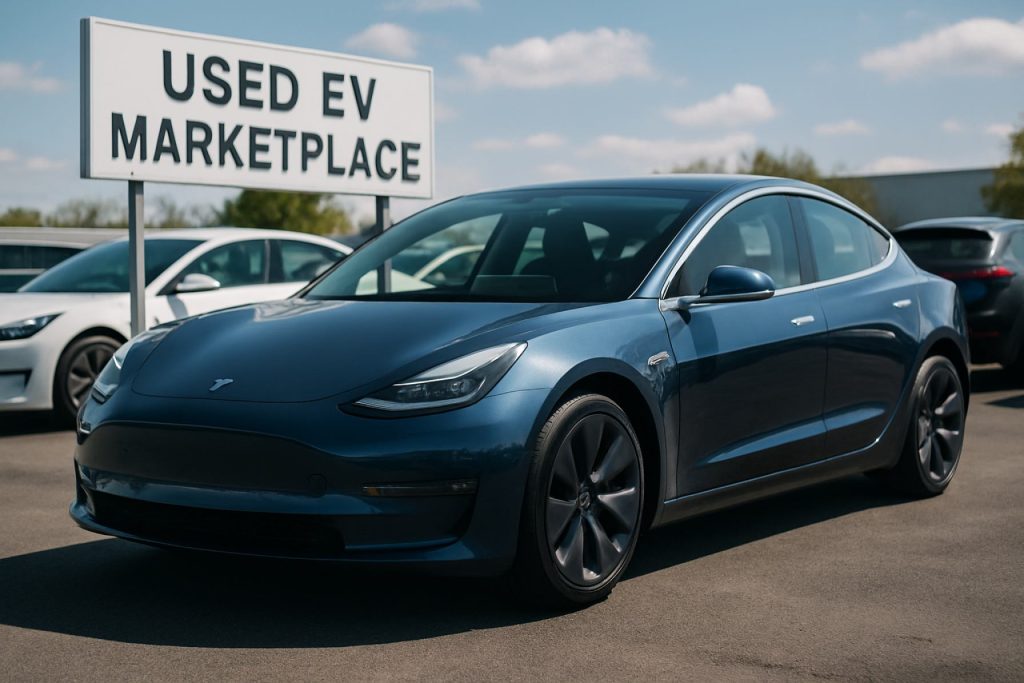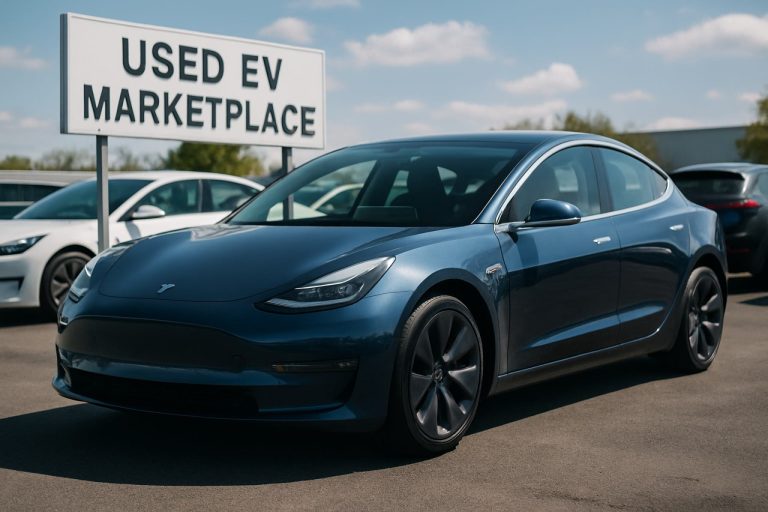
The Used EV Marketplace Revolution: How 2025 Will Redefine Pre-Owned Electric Vehicle Sales and Shape the Next Five Years. Explore the Forces Driving Unprecedented Growth and Innovation.
- Executive Summary: Key Trends and Market Outlook (2025–2030)
- Market Size, Growth Rate, and Forecasts: Used EV Marketplace Expansion
- Competitive Landscape: Leading Platforms and New Entrants
- Consumer Demand Shifts: Demographics, Preferences, and Barriers
- Technology Innovations: Battery Health, Vehicle History, and Digital Platforms
- Regulatory Environment: Policies, Incentives, and Compliance
- Supply Chain Dynamics: Sourcing, Refurbishment, and Logistics
- Pricing Models and Residual Value Trends
- Partnerships, Mergers, and Strategic Alliances
- Future Outlook: Opportunities, Risks, and Market Projections to 2030
- Sources & References
Executive Summary: Key Trends and Market Outlook (2025–2030)
The used electric vehicle (EV) marketplace is entering a pivotal phase in 2025, shaped by a confluence of maturing EV fleets, evolving consumer preferences, and regulatory momentum. As the first wave of mass-market EVs—originally sold between 2018 and 2022—enters the secondary market in significant volumes, the sector is experiencing rapid growth and transformation. This influx is driven by increased lease returns, fleet renewals, and the natural lifecycle of early EV adopters upgrading to newer models.
Major automotive manufacturers and digital platforms are responding by expanding their certified pre-owned (CPO) EV programs and dedicated online marketplaces. Ford Motor Company and General Motors have both launched initiatives to certify and remarket used EVs, aiming to build consumer trust through battery health guarantees and transparent vehicle histories. Meanwhile, digital-first players such as Cars.com and Autotrader are enhancing their platforms with EV-specific filters, battery analytics, and charging infrastructure information to facilitate informed purchasing decisions.
Data from industry bodies indicate that used EV sales are projected to outpace new EV sales growth rates between 2025 and 2030, as affordability becomes a key driver for mainstream adoption. The average price gap between new and used EVs is expected to widen, making the secondary market increasingly attractive to cost-conscious buyers. Battery longevity and warranty transferability remain central concerns, prompting manufacturers to extend battery coverage and offer certified diagnostics at the point of resale.
Regulatory developments are also shaping the landscape. In the United States, federal and state-level incentives for used EV purchases—such as tax credits and rebates—are being expanded to stimulate demand and accelerate fleet turnover. The European Union is similarly promoting used EV adoption through emissions targets and urban access policies, which favor zero-emission vehicles in city centers.
Looking ahead to 2030, the used EV marketplace is expected to become a cornerstone of the broader electrification ecosystem. The proliferation of digital marketplaces, combined with advances in battery health assessment and transparent vehicle histories, will likely reduce perceived risks and increase liquidity. As automakers, digital platforms, and policymakers align their efforts, the used EV sector is poised for sustained growth, playing a critical role in democratizing access to electric mobility and supporting global decarbonization goals.
Market Size, Growth Rate, and Forecasts: Used EV Marketplace Expansion
The used electric vehicle (EV) marketplace is experiencing rapid expansion in 2025, driven by a maturing new EV market, increased consumer acceptance, and a growing supply of off-lease and trade-in vehicles. As early adopters upgrade to newer models, the volume of used EVs entering the market is rising, creating new opportunities for both traditional automotive retailers and digital-first platforms.
Major automotive manufacturers and dedicated online platforms are investing heavily in the used EV segment. Tesla, Inc. operates its own certified pre-owned program, offering used Tesla vehicles directly to consumers with warranties and quality assurances. Similarly, Nissan Motor Corporation and BMW Group have expanded their certified used EV programs, reflecting growing confidence in battery longevity and residual values.
Digital marketplaces are playing a pivotal role in scaling the used EV market. Cars.com and Autotrader have significantly increased their EV inventory and now offer advanced filtering for battery health, range, and charging compatibility. Meanwhile, specialist platforms such as Carvana Co. and Vroom, Inc. are leveraging online-only models to streamline the buying process, including at-home delivery and digital paperwork, which is particularly attractive to tech-savvy EV buyers.
In 2025, the used EV market is projected to outpace the growth rate of the overall used car sector. The supply of used EVs is expected to increase by over 30% year-on-year, fueled by the expiration of three-year leases from the surge in new EV sales between 2021 and 2023. This influx is expected to continue through 2027, as more automakers ramp up EV production and leasing programs. The average price gap between used EVs and comparable internal combustion engine (ICE) vehicles is narrowing, making EVs more accessible to a broader segment of buyers.
Looking ahead, the used EV marketplace is set for continued robust growth. Automakers are investing in battery certification and refurbishment programs to reassure buyers about battery health, a key concern in the secondary market. Additionally, the expansion of public charging infrastructure and improvements in battery technology are expected to further boost demand for used EVs. As a result, industry stakeholders anticipate that by 2027, used EVs could represent up to 15% of all used vehicle transactions in leading markets, up from less than 5% in 2023.
Competitive Landscape: Leading Platforms and New Entrants
The competitive landscape of used electric vehicle (EV) marketplaces in 2025 is rapidly evolving, shaped by the growing adoption of EVs, increased consumer awareness, and the influx of both established automotive players and digital-first startups. As the volume of used EVs entering the market accelerates—driven by early lease returns and fleet renewals—platforms are racing to capture market share by offering differentiated services, robust vehicle certification, and seamless digital experiences.
Among the most prominent players is Cars.com, a long-standing automotive marketplace that has expanded its focus to include dedicated EV search filters, educational resources, and partnerships with certified EV dealers. Similarly, Autotrader has enhanced its platform with EV-specific listings and tools, leveraging its extensive dealer network to facilitate nationwide access to pre-owned electric vehicles.
Automakers themselves are increasingly active in the used EV space. Tesla, Inc. operates its own certified pre-owned program, listing used Tesla vehicles directly to consumers with warranties and inspection guarantees. This direct-to-consumer approach allows Tesla to maintain control over pricing, quality, and customer experience, setting a benchmark for other OEMs. Nissan and Ford Motor Company have also launched certified pre-owned EV programs, often in collaboration with their dealer networks, to support the resale of models like the Nissan LEAF and Ford Mustang Mach-E.
Digital-native entrants are reshaping the market with technology-driven solutions. Carvana and Vroom have integrated EV-specific inspection protocols and battery health assessments into their online purchasing processes, addressing consumer concerns about battery longevity and vehicle condition. These platforms offer nationwide delivery and return policies, further lowering barriers for used EV buyers.
New entrants are also emerging, targeting the unique needs of EV buyers. Startups are developing platforms focused exclusively on electric vehicles, offering features such as real-time battery diagnostics, charging network integration, and transparent total cost of ownership calculators. While many of these companies are still in early stages, their presence signals a shift toward more specialized, data-driven marketplaces.
Looking ahead, the competitive landscape is expected to intensify as more automakers introduce certified pre-owned EV programs and as digital platforms invest in advanced analytics, battery certification, and customer education. The convergence of traditional automotive expertise and digital innovation is likely to define the next phase of growth in the used EV marketplace sector through 2025 and beyond.
Consumer Demand Shifts: Demographics, Preferences, and Barriers
The used electric vehicle (EV) marketplace in 2025 is experiencing significant shifts in consumer demand, driven by evolving demographics, changing preferences, and persistent barriers. As the first wave of mass-market EVs—launched in the late 2010s and early 2020s—enters the secondary market, a broader and more diverse group of buyers is engaging with used EVs. This trend is particularly evident among younger consumers and urban dwellers, who are attracted by lower upfront costs, environmental benefits, and the growing availability of models with improved range and features.
Demographically, millennials and Generation Z are emerging as key drivers of used EV adoption. These groups, often more environmentally conscious and digitally savvy, are leveraging online platforms to research and purchase vehicles. Companies such as Cars.com and Autotrader have expanded their EV-specific search tools, making it easier for consumers to compare battery health, range, and total cost of ownership. Additionally, dedicated EV marketplaces like Carvana and Vroom are investing in transparent battery diagnostics and certified pre-owned EV programs to address consumer concerns about battery degradation and vehicle reliability.
Preferences are also shifting as consumers become more familiar with EV technology. Range anxiety, once a major deterrent, is diminishing due to improvements in battery technology and the expansion of public charging infrastructure by companies such as Tesla and ChargePoint. Buyers are increasingly prioritizing vehicles with longer ranges, faster charging capabilities, and advanced driver-assistance features. The availability of popular models like the Nissan LEAF, Chevrolet Bolt, and Tesla Model 3 on the used market is broadening appeal and providing more options at various price points.
Despite these positive trends, several barriers remain. Uncertainty about battery longevity and replacement costs continues to be a primary concern for used EV buyers. While some manufacturers, such as Nissan and Chevrolet, offer transferable battery warranties, coverage varies widely and is often a point of confusion. Additionally, regional disparities in charging infrastructure and state-level incentives can limit the attractiveness of used EVs in certain markets.
Looking ahead, the used EV marketplace is expected to grow rapidly through the late 2020s as more vehicles reach the end of their initial leases and ownership cycles. Industry stakeholders are responding by enhancing transparency, standardizing battery health reporting, and expanding certified pre-owned programs. These efforts, combined with increasing consumer awareness and supportive policy measures, are likely to accelerate the mainstream adoption of used EVs in the coming years.
Technology Innovations: Battery Health, Vehicle History, and Digital Platforms
The used electric vehicle (EV) marketplace is undergoing rapid transformation in 2025, driven by technological innovations that address key consumer concerns: battery health, vehicle history transparency, and seamless digital transactions. As the global EV fleet matures and early adopters trade in their vehicles, the secondary market is expanding, with technology playing a pivotal role in building buyer confidence and streamlining the purchase process.
Battery health remains the most critical factor influencing used EV valuations. In response, several automakers and technology providers have introduced advanced battery diagnostics tools. For example, Nissan Motor Corporation and Renault Group have integrated battery state-of-health (SOH) reporting into their certified pre-owned EV programs, providing buyers with verifiable data on remaining battery capacity and expected lifespan. These diagnostics are often accessible via in-vehicle displays or official mobile apps, allowing for transparent, real-time assessments.
Vehicle history reporting has also evolved to meet the unique needs of EVs. Traditional vehicle history providers are now incorporating EV-specific data, such as battery replacement records, charging patterns, and software update histories. Volkswagen AG and Tesla, Inc. have begun offering digital service records accessible to subsequent owners, ensuring that critical maintenance and battery events are documented and transferable. This transparency is crucial for buyers seeking assurance about the long-term reliability of used EVs.
Digital platforms are at the forefront of the used EV marketplace revolution. Dedicated online marketplaces, such as Cars.com and Autotrader, have expanded their EV-specific search tools, enabling users to filter by battery health, range, and charging compatibility. These platforms often partner with automakers and certified dealerships to provide verified listings, integrated financing, and even remote vehicle inspections. Additionally, some automakers, including BMW Group and Hyundai Motor Company, have launched their own certified pre-owned EV sales portals, leveraging proprietary data to enhance trust and streamline transactions.
Looking ahead, the next few years are expected to bring further integration of telematics, blockchain-based service records, and AI-driven pricing models to the used EV market. As battery analytics become more sophisticated and digital platforms mature, consumer confidence in used EV purchases is likely to rise, supporting broader adoption and a more robust secondary market.
Regulatory Environment: Policies, Incentives, and Compliance
The regulatory environment for used electric vehicle (EV) marketplaces in 2025 is shaped by a combination of evolving government policies, targeted incentives, and compliance requirements designed to accelerate the adoption of zero-emission vehicles. As the global push for decarbonization intensifies, national and regional authorities are increasingly recognizing the importance of the used EV sector in achieving climate goals, ensuring equitable access to clean mobility, and supporting the circular economy.
In the United States, the Inflation Reduction Act of 2022 introduced a federal tax credit of up to $4,000 for qualifying used EV purchases, provided the vehicle is at least two years old and meets specific price and income thresholds. This incentive, administered by the Internal Revenue Service, is expected to remain in effect through 2032, directly supporting the affordability and turnover of used EVs. Several states, including California and New York, have layered additional rebates or sales tax exemptions for used EV buyers, further stimulating demand and encouraging marketplace growth. The U.S. Environmental Protection Agency continues to set ambitious emissions standards, indirectly boosting the value proposition of used EVs as compliance with stricter regulations becomes more challenging for internal combustion vehicles.
In the European Union, the regulatory landscape is shaped by the Fit for 55 package and the impending Euro 7 standards, which tighten emissions limits and promote the transition to electric mobility. While most incentives have historically targeted new EVs, several member states—such as France and Germany—have introduced or expanded subsidies for used EV purchases and battery replacements. The European Automobile Manufacturers’ Association (ACEA) and the European Commission are also working on harmonizing battery health and traceability standards, which will impact how used EVs are certified and traded across borders.
China, the world’s largest EV market, has begun to address the used EV sector with new policies aimed at standardizing battery health assessments and facilitating interprovincial transfers of used electric vehicles. The Ministry of Industry and Information Technology (MIIT) is piloting digital platforms for battery traceability and has signaled further regulatory support for used EV transactions, recognizing their role in achieving national electrification targets.
Looking ahead, compliance requirements for used EV marketplaces are expected to tighten, particularly around battery health disclosure, data transparency, and environmental reporting. Marketplaces and dealers will need to adapt to evolving standards, invest in diagnostic technologies, and collaborate with manufacturers and regulators to ensure trust and safety in the secondary EV market. As incentives and regulations continue to evolve, the used EV marketplace is poised for significant growth, with policy frameworks playing a pivotal role in shaping its trajectory.
Supply Chain Dynamics: Sourcing, Refurbishment, and Logistics
The supply chain dynamics of used EV marketplaces in 2025 are shaped by the rapid expansion of electric vehicle adoption, evolving refurbishment practices, and the increasing sophistication of logistics networks. As the first major wave of EVs sold in the late 2010s and early 2020s reaches the secondary market, sourcing, refurbishing, and distributing these vehicles has become a focal point for both established automakers and specialized marketplace operators.
Sourcing used EVs is increasingly driven by trade-ins, lease returns, and fleet decommissioning. Major automakers such as Tesla, Inc. and Nissan Motor Corporation have developed certified pre-owned (CPO) programs, directly channeling off-lease and trade-in vehicles into their own resale platforms. These programs ensure a steady supply of used EVs, while also maintaining brand standards and customer trust. Additionally, dedicated used EV marketplaces like Cars.com and Autotrader have expanded their inventory sourcing partnerships with rental fleets and corporate mobility providers, further diversifying the available stock.
Refurbishment is a critical step in the used EV supply chain, particularly given concerns about battery health and software updates. Automakers and third-party specialists have invested in diagnostic and reconditioning centers equipped to assess battery state-of-health, replace or repair battery modules, and update vehicle software to the latest standards. For example, Tesla, Inc. operates its own refurbishment facilities, where vehicles undergo comprehensive inspection and necessary repairs before being listed for resale. Similarly, Nissan Motor Corporation has established battery refurbishment programs, enabling the replacement or repurposing of degraded battery packs to extend vehicle lifespans and support circular economy goals.
Logistics networks for used EVs are evolving to address the unique requirements of electric vehicles, such as specialized transport for high-voltage batteries and the need for charging infrastructure at storage and distribution centers. Companies like Cox Automotive have integrated EV-specific logistics solutions, including temperature-controlled storage and battery-safe handling protocols, into their remarketing and auction operations. These advancements help minimize transit risks and ensure vehicles are delivered to buyers in optimal condition.
Looking ahead, the used EV supply chain is expected to become more efficient and transparent, aided by digital platforms that track vehicle provenance, battery health, and refurbishment history. As more automakers and marketplace operators invest in dedicated EV refurbishment and logistics capabilities, the availability and reliability of used EVs are likely to improve, supporting broader adoption and market growth through the late 2020s.
Pricing Models and Residual Value Trends
The pricing models and residual value trends in used EV marketplaces are undergoing significant transformation as the sector matures in 2025. Historically, electric vehicles (EVs) have experienced steeper depreciation compared to their internal combustion engine (ICE) counterparts, largely due to concerns over battery longevity, rapid technological advancements, and limited secondary market infrastructure. However, several factors are now reshaping these dynamics.
One of the most influential factors is the improvement in battery technology and warranties. Leading manufacturers such as Tesla, Inc. and Nissan Motor Corporation have extended battery warranties and improved battery management systems, which has increased buyer confidence in the long-term value of used EVs. For example, Tesla’s battery warranty often extends up to 8 years or 150,000 miles, directly supporting higher residual values in the secondary market.
Pricing models in 2025 are increasingly data-driven, leveraging real-time vehicle health diagnostics and telematics. Used EV marketplaces, including platforms operated by Cox Automotive (parent of Kelley Blue Book and Manheim) and Cars.com Inc., are integrating battery health reports and over-the-air software update histories into their valuation algorithms. This transparency allows for more accurate pricing, reducing the risk premium traditionally associated with used EVs.
Residual value trends are also being influenced by the growing supply of off-lease EVs. As automakers such as Ford Motor Company and Volkswagen AG have ramped up EV leasing programs in recent years, a larger volume of relatively new, well-maintained EVs is entering the used market. This influx is expected to stabilize prices and narrow the depreciation gap with ICE vehicles through 2025 and beyond.
Additionally, government incentives and evolving regulations are playing a role. In some regions, tax credits and rebates for used EV purchases are being introduced or expanded, further supporting residual values. For instance, the U.S. federal government’s used EV tax credit, as administered by the Internal Revenue Service, is expected to boost demand and help maintain higher resale prices.
Looking ahead, industry analysts anticipate that as battery replacement costs decline and charging infrastructure expands, used EVs will retain value more effectively. The convergence of improved technology, transparent pricing models, and supportive policy measures is set to make the used EV marketplace more robust and attractive for both buyers and sellers in the coming years.
Partnerships, Mergers, and Strategic Alliances
The used electric vehicle (EV) marketplace is experiencing a dynamic phase of consolidation and collaboration as companies seek to capture a growing share of the pre-owned EV sector. In 2025, strategic partnerships, mergers, and alliances are shaping the competitive landscape, driven by the need for scale, technology integration, and enhanced customer trust.
One of the most significant trends is the collaboration between traditional automotive players and digital-first used car platforms. For example, Cox Automotive, a major force in automotive services and parent of brands like Manheim and Kelley Blue Book, has expanded its partnerships with EV manufacturers and fleet operators to streamline the remarketing and certification of used EVs. These alliances aim to address consumer concerns about battery health and vehicle history, leveraging advanced diagnostics and transparent reporting.
Meanwhile, dedicated online used EV marketplaces are forging alliances with charging infrastructure providers and battery analytics firms. Cars.com and Carvana have both announced collaborations with charging network operators to offer bundled charging solutions and home charger installations for used EV buyers. These partnerships are designed to reduce barriers to EV adoption in the secondary market and enhance the overall ownership experience.
Automakers themselves are increasingly entering the used EV space through certified pre-owned (CPO) programs and digital platforms. Tesla, Inc. continues to expand its direct-to-consumer used vehicle sales, leveraging its proprietary battery health assessment tools and over-the-air software updates to differentiate its offerings. Similarly, Nissan Motor Corporation and BMW Group have strengthened their CPO programs, often in partnership with established used car marketplaces, to ensure quality and warranty coverage for pre-owned EVs.
Mergers and acquisitions are also reshaping the sector. In 2024 and 2025, several regional used EV platforms have been acquired by larger automotive retail groups seeking to expand their digital capabilities and inventory. These moves are expected to accelerate as the volume of used EVs grows, particularly with the influx of off-lease vehicles and fleet turn-ins.
Looking ahead, the next few years are likely to see further integration between used EV marketplaces, financial institutions, and insurance providers. This will enable more seamless financing and warranty solutions tailored to the unique characteristics of electric vehicles. As the market matures, strategic alliances will remain critical for building consumer confidence and supporting the rapid expansion of the used EV ecosystem.
Future Outlook: Opportunities, Risks, and Market Projections to 2030
The used electric vehicle (EV) marketplace is poised for significant transformation through 2025 and into the latter part of the decade, driven by a confluence of maturing EV fleets, evolving consumer preferences, and regulatory shifts. As early adopters of EVs begin to cycle out their first-generation vehicles, the volume of used EVs entering the market is expected to rise sharply, creating both opportunities and challenges for buyers, sellers, and platform operators.
Key players in the used EV marketplace, such as Cars.com, Autotrader, and CarMax, have expanded their EV-specific listings and are investing in tools to help consumers assess battery health and total cost of ownership. These platforms are also collaborating with manufacturers and certified service providers to offer warranties and battery diagnostics, addressing one of the main concerns for used EV buyers: battery degradation and replacement costs.
Automakers themselves are entering the used EV space more directly. For example, Tesla, Inc. operates its own certified pre-owned program, offering refurbished vehicles with limited warranties and direct sales through its website. Similarly, Nissan and Ford Motor Company have launched certified used EV programs, leveraging their dealer networks to ensure quality and transparency. These initiatives are expected to boost consumer confidence and accelerate the adoption of used EVs.
From a regulatory perspective, governments in North America, Europe, and parts of Asia are introducing incentives for used EV purchases, such as tax credits and rebates, to stimulate demand and support broader electrification goals. These policies, combined with the declining cost of batteries and improvements in charging infrastructure, are projected to make used EVs increasingly attractive to mainstream buyers through 2030.
However, the market faces several risks. Price volatility remains a concern, as rapid advancements in battery technology and new model launches can depress residual values of older EVs. Additionally, the lack of standardized battery health reporting and certification could hinder trust and slow market growth if not addressed by industry stakeholders.
Looking ahead, industry forecasts suggest that the used EV segment could account for a substantial share of overall EV sales by 2030, with digital marketplaces and certified pre-owned programs playing a pivotal role. As the ecosystem matures, collaboration between automakers, online platforms, and service providers will be essential to ensure transparency, reliability, and sustained consumer interest in the used EV market.
Sources & References
- Autotrader
- Nissan Motor Corporation
- Nissan
- ChargePoint
- Chevrolet
- Renault Group
- Volkswagen AG
- Hyundai Motor Company
- Internal Revenue Service
- European Automobile Manufacturers’ Association
- Cox Automotive
- CarMax



